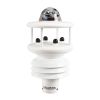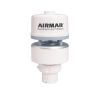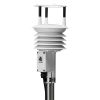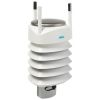Lufft WS-Series Smart Weather Sensors
Features
- Each model offers different combination of sensors to suit a range of applications
- Easily mounts to 2" diameter pipe with integrated bracket mount & U-bolts
- SDI-12 or Modbus RTU output for integration with NexSens and other data loggers
- Expedited repair and warranty service
- Lifetime technical support
- More
Overview
The Lufft WS-Series Multi-Parameter Weather Sensors simultaneously measure a combination of air temperature, humidity, pressure, precipitation, solar radiation, lightning & wind with an integrated electronic compass.
Air Temperature & Humidity (WS300, WS301, WS302, WS400, WS401, WS500, WS501, WS502, WS600, WS601, WS700, WS800)
Temperature is measured using a highly accurate NTC-resistor, while humidity is measured using a capacitive humidity sensor. Both sensors are located in a ventilated radiation shield to reduce the effects of solar radiation.
Pressure (WS300, WS301, WS302, WS400, WS401, WS500, WS501, WS502, WS600, WS601, WS700, WS800)
Absolute air pressure is measured using a built-in MEMS sensor. The relative air pressure referenced to sea level is calculated using the barometric formula with the aid of the local altitude, which is user-configurable on the equipment.
Wind Speed & Direction (WS200, WS500, WS501, WS502, WS600, WS601, WS700, WS800)
The wind sensor uses four ultrasound sensors which take cyclical measurements in all directions. The resulting wind speed and direction are calculated from the measured run-time sound differential.
Compass (WS200, WS500, WS501, WS502, WS600, WS601, WS700, WS800)
The integrated electronic compass can be used to check the north-south adjustment of the sensor housing for wind direction measurement. It is also used to calculate the compass-corrected wind direction.
Radar Precipitation (WS400, WS600, WS700, WS800)
Tried and tested radar technology is used to measure precipitation. The precipitation sensor works with a 24GHz Doppler radar, which measures the drop speed and calculates precipitation quantity and type by correlating drop size and speed.
Tipping Bucket Rainfall (WS401, WS601)
Precipitation is measured using an integrated tipping bucket rain gauge. The tipping bucket is configured for 0.2mm rainfall resolution.
Solar Radiation (WS301, WS302, WS501, WS502, WS700, WS800)
The pyranometer is intended for shortwave global solar radiation measurements in the spectral range from 300 to 1100nm (WS302, WS502, WS700, WS800) or 300 to 2800nm (WS301, WS501). The thermopile sensor construction measures the solar energy that is received from the total solar spectrum and the whole hemisphere. The output is expressed in Watts per square meter.
Lightning Detection (WS800)
Lightning detection is measured by an integrated sensor analyzing the radio wave emission of lightning, delivering a count of recognized lightning events. The sensor analyzes the spectrum and waveform of the received signal to suppress the detection of manmade electrical discharges.
- Air Temperature
- Principle: NTC
- Measuring Range: -50 to +60 C
- Resolution: 0.1 C (-20 to +50 C); otherwise 0.2 C
- Accuracy: +/-0.2 C (-20 to +50 C); otherwise +/-0.5 C
- Units: C; F
- Humidity
- Principle: Capacitive
- Measuring Range: 0 to 100% RH
- Resolution: 0.1% RH
- Accuracy: +/-2% RH
- Units: % RH; g/m3; g/kg
- Pressure
- Principle: Capacitive
- Measuring Range: 300 to 1200hPa
- Resolution: 0.1hPa
- Accuracy: +/-1.5hPa
- Unit: hPa
- Radiation
- Response Time (95%): <1s
- Spectral Range: 300 to 1100 nm
- Measuring Range: 1400 W/m2
- Wind Speed
- Principle: Ultrasonic
- Measuring Range: 0 to 60m/s
- Resolution: 0.1m/s
- Accuracy: +/-0.3m/s or 3% (0 to 35m/s); +/-5% (>35m/s)
- Response Threshold: 0.3m/s
- Units: m/s; km/h; mph; kts
- Wind Direction
- Principle: Ultrasonic
- Measuring Range: 0 to 359.9 degrees
- Resolution: 0.1 degrees
- Accuracy: +/-3 degrees
- Response Threshold: 0.3m/s
- Compass
- Principle: Integrated Electronic Compass
- Measuring Range: 0 to 359.9 degrees
- Resolution: 1.0 degree
- Precipitation
- Principle: Radar
- Measuring Range: 0.3mm to 5.0mm
- Liquid Precipitation Resolution: 0.01mm
- Precipitation Types: Rain, Snow
- Repeatability: Typically> 90%
- Response Threshold: 0.01mm
- Technical Data
- Interface: SDI-12, Modbus
- Operating Temperature: -50 to +60 C
- Operating Humidity: 0 to 100% RH
In The News
Monitoring Lake Erie’s Eastern Basin: Building Long-Term Data and Real-Time Public Solutions
In the eastern basin of Lake Erie, off the coast of Dunkirk, New York, a data buoy collects valuable water quality, weather, and wave data that inform residents and regulatory groups of conditions on the water. Since 2011, Buffalo State University’s Great Lakes Center has maintained and operated the Dunkirk buoy with funding from the Great Lakes Observing System (GLOS) and field support from the NYSDEC Lake Erie Fisheries Research Unit. [caption id="attachment_38976" align="aligncenter" width="940"] The Dunkirk Buoy viewed from the research vessel after being deployed in early spring.
Read MoreClimate Change and Microplastics: Monitoring Lake Champlain
Most people go to Lake Champlain for its exceptional views and thrilling boating, but it’s also home to a wide variety of interesting aquatic research projects. From studying microplastics to thermal dynamics of the lake, Timothy Mihuc, director of the Lake Champlain Research Institute (LCRI) at the State University of New York at Plattsburgh (SUNY Plattsburgh), has spent his career studying aquatic ecosystems. As an aquatic biologist, he’s the main investigator on Lake Champlain’s research studies while also managing their grants, employees, and their hands-on buoy work. Over the years, LCRI has received a number of environmental grants that aid in its monitoring research.
Read MoreBefore and After Harmful Algal Blooms: Long-Term Monitoring and Modeling in Otsego Lake
Throughout the years, harmful algal blooms (HABs) in the Laurentian Great Lakes have been meticulously documented and closely studied due to their annual appearance across the basin. While these blooms have become a recurrent issue in the Great Lakes region, many lakes worldwide are now facing harmful algal blooms for the very first time, with some causes still unknown. Otsego Lake is one example of a lake that experienced its first harmful algal bloom in 2022, leaving state agencies and researchers to wonder what triggered the event. Kiyoko Yokota, an associate professor of biology with the State University of New York (SUNY) at Oneonta, is the lead researcher of the project.
Read More
































